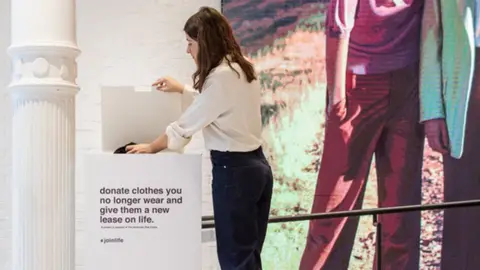Zara uncovered: Inside the brand that changed fashion
 Zara
ZaraI am seeing spots. More specifically polka dots, on a white maxi dress. Three women have walked by me - all wearing the same identical dress - in the half hour I've been sitting outside this café. I know it's from Zara, I've tried it on, and now I'm seeing those spots everywhere.
It is the dress of the summer, another viral Zara fashion statement, complete with a dedicated Instagram account set up by fans.
Just one sign of how the Spanish clothing giant is bucking the trend of many of its struggling High Street competitors and posting record sales.
Considering the success and size of the company, it might be thought of as a bit of an enigma. It doesn't advertise, it does little marketing and its boss, who was named best performing chief executive in the world by a business magazine last year, has not given any big interviews, until now.
Pablo Isla recently laid out plans for Zara's future and said it was all about a digital and sustainable transformation. But is it possible for a company to be sustainable, when the entire business is about getting shoppers to buy as much fashion as possible?
'No contradiction'
Speaking at their campus-like headquarters in northern Spain, Pablo Isla, the chairman of Zara and its parent company Inditex, tackled the sustainability issue.
"There is no contradiction at all between sustainability and profitability of the company," he says.
 Zara
Zara"In the next year, all our stores in the world will be efficient - this means their consumption of energy and water is significantly lower. If your energy consumption is 20% less, you have a return."
In fact some of the key ways in which the business works helps with its sustainability goal. Mr Isla explains that Zara works with a "low level of inventory".
This helps the retailer minimise waste and avoid discounting huge amounts of clothing.
On my tour of the headquarters, I walk past rows of desks where staff are analysing instant data from Zara's store managers.
They use this information to decide what to make each week - Zara's factories will only make what they know will sell. Most of Zara's clothes are manufactured at its sites in Spain or in nearby Portugal, Morocco and Turkey.
'Long-term relations'
One of the key factories producing Zara's womenswear is just next to the head office. This way of working is all about speed, which allows Zara to get fresh trends into stores before their competitors.
But it hasn't always meant being able to keep a close eye on standards. Two years ago, some Zara customers in Turkey found notes in clothes from workers saying they hadn't been paid and asking for them to back calls for better working standards. When asked about it, Mr Isla says working with these suppliers was an "evolution".
He says "the most important thing is the idea of long-term relations with our suppliers" when it comes to keeping an eye on working conditions.
Fashion Revolution is an independent organisation which monitors where clothes come from and how ethical they are. They say Zara needs to provide more information about where their clothes are made to be held accountable for standards.
"Inditex, which owns Zara, remains one of the major fashion retailers that is dragging its feet on publishing a list of its manufacturers," says Fashion Revolution policy director Sarah Ditty.
"Other brands have published a list and proved that doing so doesn't hurt them competitively. "
Recycled plastics
Back at headquarters, I wander through the pilot store built on-site - a perfectly-kept Zara shop where everything is in place - but there are no shoppers. This is where Zara test how everything should look and feel, from lighting to displays.
They are aiming to reach zero waste in store - all packaging is made from recyclable cardboard and plastic. Recycling is a big theme for the clothes too.
 Zara
ZaraThey have been working with the renowned US university MIT to develop ways of making fabric from recycled plastics. I take the opportunity to feel the texture of some of the latest recycled plastic clothes from their sustainable line. The cloth feels silky to the touch.
Mr Isla has committed to 100% of the cotton, linen, and polyester used by Zara - and all of its sister companies - being organic, sustainable, or recycled by 2025.
Sarah Ditty from Fashion Revolution says that while it is great to see Zara taking steps to incorporate more sustainable material into its ranges, it is essential action that all brands should be taking.
However, she highlights that the real issue is all about the sheer volume of clothes they make.
Inditex reported putting over 1.5 billion products on the market in 2017 alone. Even with more environmentally-friendly materials, producing that many items each year is unsustainable for our living planet.
How much clothing we buy is a marker of just how much the industry has grown and changed in a short space of time. The UK has the highest rate of consumption in Europe, at 27.6kg per person per year.
Customer decisions
Indeed, Zara has an enormous turnaround, fashion influencer Jasmine Jonas tells me.
"I feel confident walking into a Zara, [being] able to find something that will look good, fit well, and that I can afford. But across the board, demand for eco-conscience clothing is rising."
It's not just Fashion Revolution - many campaigners say the only way to truly tackle sustainability in fashion is to make and sell less.
But how can that be a solution for Zara and Inditex if they want to keep those record-breaking sales?
 LightRocket / Getty Images
LightRocket / Getty Images"It's always the customers' decision of how much do they buy of each particular product," says Mr Isla.
"I think our responsibility as a company is taking care of manufacturing our products in a very sustainable way. Each customer, each person, is free to decide how much would he or she like to buy at any point in time, if this person wants to spend money going to a restaurant or buying clothes... this is the freedom that each person has."
"Should I, shouldn't I?" is the age-old changing room debate, but does it take on a new dimension if, as Pablo Isla says, it is ultimately in shoppers' hands to decide the crucial sustainability issue?
In the meantime, Zara says it will do what it can to keep the environmental conundrum for customers to a minimum.
